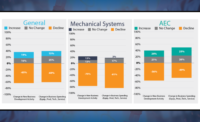The COVID-19 pandemic has infected an estimated 9.7 million people worldwide and claimed the lives of more than 493,000. While the rate of infection once appeared to be decreasing, the threat has since ramped up as several areas of the country chose to step out of lockdown.
It is becoming increasingly more apparent that business protocols recognized as “normal” in 2019 may not resurface for months or even years.
Over the last three months, Engineered Systems has tracked the results of five “Industry Perspective on the Challenges of Today” surveys, presented by Clear Seas Research, that examined how architecture, engineering, and construction (AEC) firms and mechanical systems companies are navigating their way through the coronavirus pandemic.
The fifth-wave results are now in, and the data, collected June 4-8, provides a comprehensive examination of how far we’ve come in the last 12 weeks, where we are today, and what the future may hold.
As time ticks on, and the COVID-19 pandemic continues to evolve, Engineered Systems remains committed to providing the most up-to-date, pertinent information possible to help facility managers and consulting/specifying engineers manage their operations during this unprecedented time. The quotes included in this article were provided by those completing the survey. We hope you find this study worthwhile.
Future Employment
AEC firms are feeling more and more confident about retaining employees over the next three months.
In the most recent survey, 34% of survey’s 840 respondents stated they don’t foresee any workforce changes in the next three months. Additionally, 24% are planning to hire new employees in that timeframe. This is a 17% increase when compared to the first wave of this survey, conducted March 24-26, a 13% increase from the April 2-6 results, a 12% increase from the April 16-20 survey results, and an 11% increase from the April 30-May 4 results.
My company laid off 70% of employees in March 2020 due to COVID-19,” said one respondent. “They are now beginning to call people back, so unless there is a Phase II of COVID that makes companies lay off again, then I think work will trend up again.”
Primary Concerns
A total of 372 AEC companies and 71 mechanical systems representatives responded to the June 4-8 survey. Cumulatively, across all five surveys, representatives from 1,848 AEC and 426 mechanical systems companies participated in the survey.
When asked to identify their biggest areas of concern, 57% of respondents identified the current state of the economy. This represents a 17% decrease from the April 30-May 4 results. Fifty-six percent of respondents identified a potential second wave as their second most-pressing concern.
“From our headquarters we want all this to end so that we can function normally and with our full capacity,” said one respondent. “For now, we only operate online and with some direct partners to do any job, now we do not give quotes and we do not make site visits.”
Getting Back to Work
When it comes to active business, 61% of responding firms report they are completing their jobs on schedule, while 26% of projects have been delayed, and 13% of projects have been cancelled.
Regarding planned business, approximately 59% of companies reported everything was running on schedule — an 8% increase from the previous survey — 28% of projects have been delayed, and 12% of projects have been canceled.
Unemployment Expectations
Over the next three months, 17% of respondents stated that they intend to lay off some or all employees, while 21% intend to rehire employees.
Ten percent plan to lay off employees without pay and 8% intend to lay off employees with pay. These numbers are down 9% and 13%, respectively, from the initial March 24-26 Clear Seas Research survey.
Prospective Business Opportunities
Regarding the state of business operations, 60% of respondents said they were experiencing declines in new business activity — a 5% increase from the first survey — while 24% reported increases in new business activity.
“To paraphrase the inimitable Yogi Berra, prediction is hard, especially about the future,” said one respondent. “There are so many variables involved today internationally, nationally, locally, individually, industry-related, and epidemiologically that trying to predict our future in any way is practically impossible. Risk analysis depends on having some sense of the shape of the risk curve, but we're at cusps in many areas and the curves can go in radically different directions at cusps.”
Implementing New Approaches
A number of companies have refocused their business efforts to the internet. The most recent survey results reflect that as 66% of respondents said they’re now using video chat/conferencing software, 60% are using cloud services, 48% are using video surveillance, and 38% are using social media monitoring. Additionally, 52% have pushed ahead their efforts to implement infrared fever warning systems.
When Will it End?
We all want to know how much longer our lives will be impacted by the COVID-19 pandemic. When asked to define the estimated time it will take for a business to get back on track, 26% of respondents said four to six months or less, 24% said three months or less, 15% said 10-12 months, and 14% said their business hasn’t been affected at all.
When asked to list the areas they are devoting greater focus to when compared to their activities of six months ago, 48% of respondents vowed to incorporate additional health/safety procedures into business plans, 44% said they intend to attend more webinars, and 34% said they intend to read more industry publications. For more information, or to see the entire fifth-wave survey, visit www.clearseasresearch.com/totalreport.





